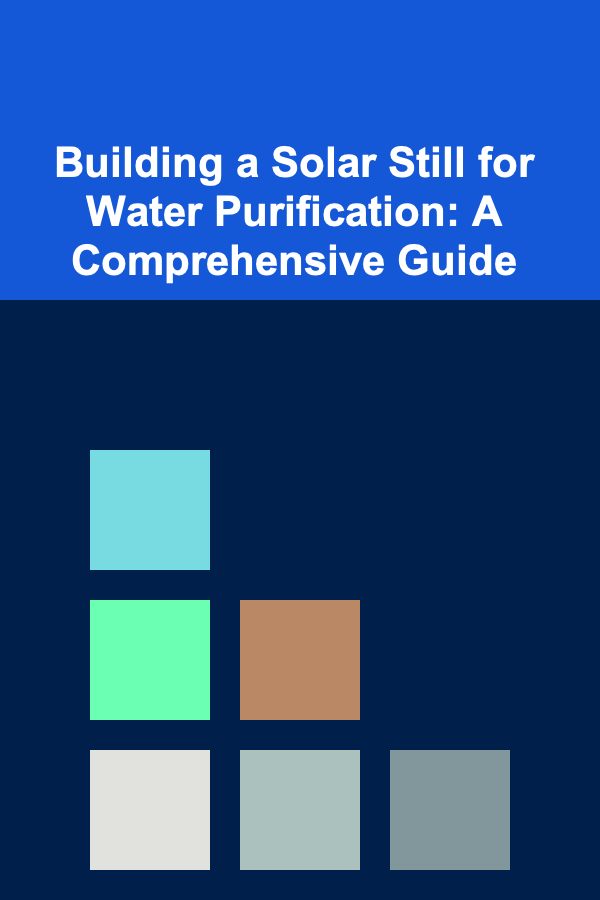
Building a Solar Still for Water Purification: A Comprehensive Guide
ebook include PDF & Audio bundle (Micro Guide)
$12.99$9.99
Limited Time Offer! Order within the next:

Access to clean, potable water is a fundamental human need. Unfortunately, billions of people worldwide lack reliable access to safe drinking water, leading to a host of health problems and hindering socio-economic development. While advanced water purification technologies exist, they are often expensive, energy-intensive, and require specialized infrastructure, making them inaccessible to many communities, particularly in developing countries and remote areas. This is where solar stills offer a practical and sustainable solution. Solar stills utilize the sun's energy to evaporate contaminated water, separating it from impurities and producing clean distillate. This guide will provide a detailed and comprehensive overview of how to build and use a solar still for water purification, covering various designs, material considerations, operational best practices, and troubleshooting tips.
Understanding the Principles of Solar Distillation
Solar distillation mimics the natural water cycle. The process involves four key stages:
- Evaporation: Contaminated or impure water is placed in a shallow container. Solar radiation heats the water, increasing its temperature and causing it to evaporate. The rate of evaporation is influenced by factors such as the intensity of sunlight, ambient temperature, relative humidity, and the surface area of the water exposed to the sun.
- Vaporization: As the water evaporates, it transforms into water vapor. This vapor rises within the enclosure of the solar still.
- Condensation: The water vapor comes into contact with a cooler condensing surface, typically a sloped glass or plastic cover. The temperature difference between the vapor and the condensing surface causes the vapor to cool and condense back into liquid water.
- Collection: The condensed water droplets run down the condensing surface and are collected in a designated trough or container. This collected water is the purified distillate.
Solar distillation effectively removes a wide range of contaminants, including:
- Particulates: Suspended solids like dirt, sand, and sediment.
- Microorganisms: Bacteria, viruses, protozoa, and parasites that can cause waterborne diseases. The high temperatures reached during evaporation effectively kill most pathogens.
- Heavy metals: Lead, mercury, arsenic, and other toxic metals that can accumulate in the body and cause serious health problems.
- Salts: Dissolved salts that make water brackish or saline, rendering it undrinkable.
- Organic compounds: Pesticides, herbicides, and other harmful chemicals.
Types of Solar Stills
Solar stills come in various designs, each with its own advantages and disadvantages. The choice of design depends on factors such as available materials, desired production rate, environmental conditions, and ease of construction.
Box-Type Solar Still (Single-Sloped)
The box-type solar still is the most common and simplest design. It consists of an insulated box with a transparent cover, usually made of glass or plastic, sloped towards a collection trough. The contaminated water is placed inside the box, and solar radiation heats the water, causing it to evaporate. The vapor condenses on the underside of the transparent cover and flows down into the collection trough.
Advantages:
- Simple and inexpensive to build.
- Requires readily available materials.
- Relatively durable.
Disadvantages:
- Lower production rate compared to other designs.
- Can be bulky and less portable.
- Performance is sensitive to the angle of the sun.
Wick-Type Solar Still
Wick-type solar stills utilize an absorbent material, such as cloth or sponge, to increase the surface area of the water exposed to solar radiation. The wick is soaked in the contaminated water, and the water evaporates from the surface of the wick. The vapor then condenses on a transparent cover and is collected.
Advantages:
- Higher production rate compared to box-type stills due to increased evaporation surface area.
- Can be more compact than box-type stills.
Disadvantages:
- Requires regular replacement of the wick material as it can become contaminated or degraded.
- More complex to construct than box-type stills.
- Performance is dependent on the wicking ability of the material.
Concentrating Solar Still
Concentrating solar stills use reflectors, such as mirrors or polished metal sheets, to focus sunlight onto the water container, increasing the intensity of solar radiation and accelerating the evaporation process. These stills are typically more complex and expensive to build than other designs.
Advantages:
- Highest production rate compared to other designs.
- Can operate effectively even in less sunny conditions.
Disadvantages:
- More complex and expensive to build.
- Requires precise alignment of the reflectors.
- Can be more susceptible to damage from wind and weather.
Inflatable Solar Still (Emergency Still)
This is a very simple design for emergency situations. It involves digging a pit, placing a container in the center, and covering the pit with plastic sheeting. A small weight is placed in the center of the plastic to create a cone shape that directs condensation towards the container. The pit collects any available moisture in the ground, as well as rainwater. Sunlight heats the air under the plastic, causing evaporation and condensation.
Advantages:
- Extremely simple and requires minimal materials.
- Easy to construct in survival situations.
- Can collect water from the ground as well as rainwater.
Disadvantages:
- Low production rate.
- Can be easily contaminated if the materials are not clean.
- Affected by soil type and moisture content.
Building a Box-Type Solar Still: A Step-by-Step Guide
This section provides a detailed guide to building a simple and effective box-type solar still. This design is ideal for beginners due to its simplicity and use of readily available materials.
Materials Needed:
- Insulated box: A wooden box, polystyrene box, or even a large container can be used. The size of the box will determine the water capacity and production rate. An ideal size is approximately 2 feet long, 1 foot wide, and 6 inches deep. Ensure the box is watertight. If using wood, seal the interior with a waterproof sealant.
- Transparent cover: A sheet of glass or clear plastic (polycarbonate or acrylic) that is slightly larger than the top of the box. Glass is more durable and provides better transmission of solar radiation, but plastic is lighter and less prone to breakage. Aim for a thickness of at least 3mm for glass and 4mm for plastic to provide sufficient strength.
- Black paint or liner: Used to line the interior of the box to absorb more solar radiation. A non-toxic, heat-resistant black paint is recommended. Black plastic sheeting can also be used.
- Collection trough: A length of PVC pipe cut in half, a plastic gutter, or any other suitable container to collect the distilled water. It should be placed along the lower edge of the transparent cover.
- Silicone sealant: Used to seal the joints between the box, the transparent cover, and the collection trough to prevent water leakage.
- Weight (optional): A small stone or metal object to weigh down the center of the plastic film (if using) in inflatable emergency stills.
- Insulation material: Optional, but recommended. Insulation, such as polystyrene foam or fiberglass, can be used to line the exterior of the box to reduce heat loss.
- Tools: Saw (if constructing a wooden box), utility knife, measuring tape, paintbrush, and safety glasses.
Construction Steps:
- Prepare the box: Construct or modify your chosen container into a watertight box. If using wood, cut the wood to the desired dimensions and assemble the box using nails, screws, or glue. Seal the interior of the box with a waterproof sealant to prevent leaks and ensure the box is durable.
- Line the interior: Paint the interior of the box with black paint or line it with black plastic sheeting. This will maximize the absorption of solar radiation and increase the efficiency of the still. Ensure the paint is fully dry before proceeding.
- Install the collection trough: Position the collection trough along the lower edge of the box, beneath where the transparent cover will be placed. Secure the trough to the box using silicone sealant or screws. Ensure the trough is slightly tilted towards one end to allow the distilled water to drain into a collection container.
- Position the water basin: Place a smaller, heat-resistant, and non-reactive basin inside the larger box. This basin will hold the water to be purified. Ensure that there is enough space around the basin for the water vapor to circulate. The depth of the basin should be relatively shallow to maximize the surface area exposed to sunlight.
- Attach the transparent cover: Cut the transparent cover (glass or plastic) to the correct size, ensuring it is slightly larger than the top of the box. Angle the cover so that it slopes towards the collection trough. This angle is crucial for efficient condensation and collection. A slope of 10-20 degrees is generally recommended. Secure the cover to the box using silicone sealant, ensuring a tight and watertight seal. You may need to use clamps or weights to hold the cover in place while the sealant dries.
- Insulate the box (optional): Attach insulation material to the exterior of the box to reduce heat loss. This will improve the efficiency of the still, especially in colder climates.
- Seal all joints: Thoroughly inspect all joints and seams and seal them with silicone sealant to prevent water leakage. This is essential for preventing the loss of distilled water and ensuring the still operates efficiently.
Operational Considerations:
- Water Source: Select a reliable source of contaminated water. While the still can purify a wide range of water sources, heavily contaminated water may require pre-filtration to remove large debris.
- Water Level: Fill the basin with contaminated water to a shallow depth (typically 1-2 inches). Avoid overfilling, as this can reduce the efficiency of the still.
- Placement: Position the solar still in a location that receives maximum sunlight throughout the day. A south-facing location is ideal in the northern hemisphere, and a north-facing location is ideal in the southern hemisphere. Ensure the still is placed on a stable and level surface.
- Angle Adjustment: For optimal performance, adjust the angle of the transparent cover throughout the year to maximize the angle of incidence of sunlight. This can be done by placing the still on an adjustable stand or by propping it up with blocks of wood.
- Collection: Place a clean container beneath the collection trough to collect the distilled water. Ensure the container is made of food-grade material and is regularly cleaned to prevent contamination.
- Cleaning: Regularly clean the interior of the box and the transparent cover to remove any accumulated dirt, algae, or mineral deposits. This will maintain the efficiency of the still and prevent contamination of the distilled water. Use a mild detergent and a soft cloth for cleaning. Avoid using abrasive cleaners, as they can scratch the transparent cover.
- Water Quality Testing: While solar distillation effectively removes most contaminants, it is recommended to periodically test the distilled water to ensure it meets drinking water standards.
- Water Storage: Store the distilled water in clean, sealed containers to prevent recontamination.
Optimizing Solar Still Performance
Several factors influence the performance of a solar still. By understanding these factors and implementing appropriate strategies, you can maximize the production rate and efficiency of your still.
Factors Affecting Performance:
- Solar Radiation: The intensity of solar radiation is the primary driver of evaporation. The higher the solar radiation, the faster the evaporation rate and the greater the production of distilled water.
- Ambient Temperature: Higher ambient temperatures generally lead to higher evaporation rates. However, extremely high temperatures can also reduce the efficiency of condensation.
- Relative Humidity: High relative humidity reduces the rate of evaporation, as the air is already saturated with moisture.
- Water Temperature: The temperature of the water in the basin directly affects the evaporation rate. Pre-heating the water can significantly increase the production rate.
- Water Depth: Shallower water depths result in faster heating and evaporation.
- Surface Area: Increasing the surface area of the water exposed to solar radiation increases the evaporation rate. This can be achieved using wick materials or multiple shallow basins.
- Condensation Surface Temperature: A cooler condensation surface promotes more efficient condensation. Shading the condensing surface or using a material with high thermal conductivity can help to lower its temperature.
- Air Leakage: Air leaks can reduce the efficiency of the still by allowing heat to escape and preventing the buildup of water vapor. Proper sealing is crucial.
- Insulation: Adequate insulation reduces heat loss from the still, improving its overall efficiency.
- Condensation Angle: The angle of the transparent cover is critical for efficient condensation and collection. An optimal angle allows the condensed water droplets to flow easily into the collection trough.
Strategies for Optimization:
- Maximize Sunlight Exposure: Position the still in a location that receives maximum sunlight throughout the day. Adjust the angle of the transparent cover seasonally to optimize the angle of incidence of sunlight.
- Use a Black Absorber: Use a dark-colored material, such as black paint or black plastic, to line the interior of the box to maximize the absorption of solar radiation.
- Provide Insulation: Insulate the exterior of the box to reduce heat loss, especially in colder climates.
- Minimize Air Leakage: Ensure all joints and seams are tightly sealed to prevent air leakage.
- Increase Water Surface Area: Use wick materials or multiple shallow basins to increase the surface area of the water exposed to solar radiation.
- Pre-heat the Water: Pre-heating the contaminated water can significantly increase the evaporation rate. This can be done by placing the water in a black container exposed to the sun before adding it to the still.
- Cool the Condensing Surface: Shade the condensing surface or use a material with high thermal conductivity to lower its temperature and promote more efficient condensation.
- Add Reflectors: Use reflectors, such as mirrors or polished metal sheets, to focus sunlight onto the water container, increasing the intensity of solar radiation and accelerating the evaporation process.
Troubleshooting Common Problems
Despite careful construction and operation, you may encounter problems with your solar still. Here are some common issues and their solutions:
Low Water Production
- Insufficient Sunlight: Ensure the still is placed in a location that receives maximum sunlight. Adjust the angle of the transparent cover to optimize the angle of incidence of sunlight.
- Air Leakage: Check for air leaks and seal them with silicone sealant.
- Insufficient Insulation: Add insulation to the exterior of the box to reduce heat loss.
- Deep Water Level: Reduce the water level in the basin to a shallow depth.
- Dirty Condensing Surface: Clean the transparent cover to remove any accumulated dirt, algae, or mineral deposits.
- High Humidity: Production will be lower on humid days. There is little that can be done except to wait for drier weather.
Water Leakage
- Poor Sealing: Check for leaks around the joints between the box, the transparent cover, and the collection trough. Reseal any leaks with silicone sealant.
- Damaged Container: Inspect the container for cracks or holes and repair or replace it as needed.
Contaminated Distilled Water
- Dirty Materials: Ensure all materials used in the construction of the still are clean and non-toxic.
- Contaminated Water Source: Pre-filter heavily contaminated water before adding it to the still.
- Dirty Collection Container: Regularly clean the collection container to prevent contamination.
- Algae Growth: Algae can grow inside the still. Regular cleaning is essential. Consider adding a small amount of copper sulfate (very sparingly and with extreme caution, as it is toxic in higher concentrations) to inhibit algae growth.
Cloudy or Discolored Distillate
- Carryover of Impurities: Some volatile organic compounds may evaporate along with the water and condense in the distillate. This is rare, but can occur. In such cases, consider using a pre-filter or adding activated carbon to the water basin to absorb these compounds.
- Material Degradation: Certain plastics can degrade over time, releasing chemicals into the water. Use food-grade plastics and replace them regularly.
Conclusion
Building a solar still is a simple and effective way to purify water using a readily available and renewable energy source: the sun. By understanding the principles of solar distillation, choosing the appropriate design, carefully constructing the still, and following best practices for operation and maintenance, you can provide yourself and your community with access to clean, safe drinking water. While solar stills may not be a complete solution for large-scale water purification, they offer a valuable and sustainable option for individuals and communities in need of reliable access to potable water, particularly in resource-constrained environments and emergency situations. Remember to prioritize safety and water quality testing to ensure the water is safe for consumption. With dedication and ingenuity, the sun can become a powerful ally in the quest for clean water for all.

Comparative Analysis: Remote Work vs. On-Site Jobs
Read More
How to Plan for Financial Success During Major Life Milestones
Read More
How to Sell Digital Products Successfully for Mental Health Professionals: An Actionable Guide
Read More
How to Cook for Picky Eaters (Healthily)
Read More
Understanding Persistent AR Experiences
Read More
Researching the Life of Pericles: A Deep Dive
Read MoreOther Products

Comparative Analysis: Remote Work vs. On-Site Jobs
Read More
How to Plan for Financial Success During Major Life Milestones
Read More
How to Sell Digital Products Successfully for Mental Health Professionals: An Actionable Guide
Read More
How to Cook for Picky Eaters (Healthily)
Read More
Understanding Persistent AR Experiences
Read More